Physical Address
304 North Cardinal St.
Dorchester Center, MA 02124
Physical Address
304 North Cardinal St.
Dorchester Center, MA 02124
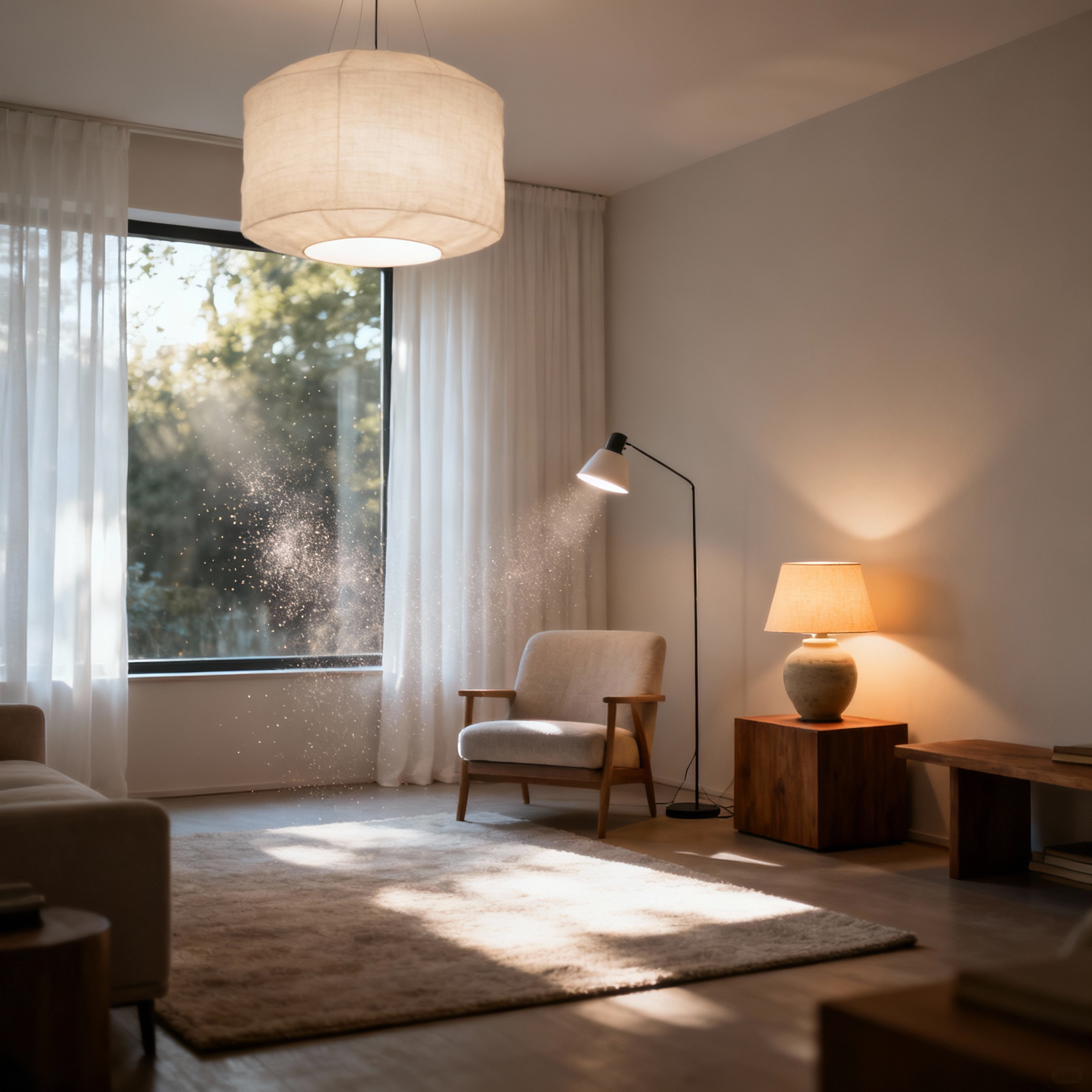
Cultivate serenity with 20 Scandinavian design insights for your living room. A guide to warm minimalism, natural materials, and creating a tranquil home.
Since our earliest days huddled around a communal fire, the living space has been the heart of the home—a place for connection and quiet rest. This idea evolved from the rugged functionality of old Nordic farmhouses into today’s deeply personal expressions of well-being. The most thoughtful modern living rooms understand a simple truth: a space must earn its place by both serving our needs and soothing our spirits. The twenty principles that separate a truly serene sanctuary from a room filled with mere things haven’t changed in generations. They are timeless.
This way of thinking is woven into the fabric of Scandinavian life, guided by philosophies like Hygge (coziness and contentment) and Lagom (the art of “just enough”). It’s about designing with intention, not for trends. We will begin by exploring the foundational principles that anchor a space in calm and balance. From there, we’ll move to the tactile dialogue of natural materials that invite touch and comfort, then to crafting spatial harmony through intelligent, flowing layouts. Finally, we’ll see how to integrate your own story, creating a sanctuary that evolves with you. These 20 insights offer more than just living room inspo; they are a map to a more tranquil way of living.
Before a single piece of furniture is chosen, we must start with the why. A serene living space is built on a philosophical foundation. Here, we’ll anchor your room in the enduring principles of well-being, balance, and quality that define the Scandinavian approach, turning simple intention into a true sanctuary.
In Scandinavia, light is more than a utility; it’s a feeling. The very soul of hygge—that cherished sense of contentment and deep coziness—is born from it. We avoid harsh, single-point overhead lighting because comfort simply doesn’t feel that way. Instead, think of the soft, embracing glow of a low winter sun or the living flicker of a fire. This is our philosophical starting point: light should welcome you, not expose you.

So how do you bring this to life? You layer. Never rely on one source. A floor lamp with a simple linen shade provides a soft, general warmth. A smaller table lamp by a favorite chair creates an intimate pool of light perfect for reading. And candles, real or the highest quality LED, are essential. They are not decor; they are active participants. This is how a room begins to breathe and feel alive, sculpted by gentle shadows and warm pockets of light.
Once you have your light, the next principle is lagom—the Swedish philosophy of “just enough.” It’s the quiet confidence of moderation. In design, this means seeking a balanced visual equilibrium, free from clutter and excess. It asks us to resist the urge to fill every empty corner and instead curate with purpose. A room designed with lagom feels calm and clear because every single object has earned its place.
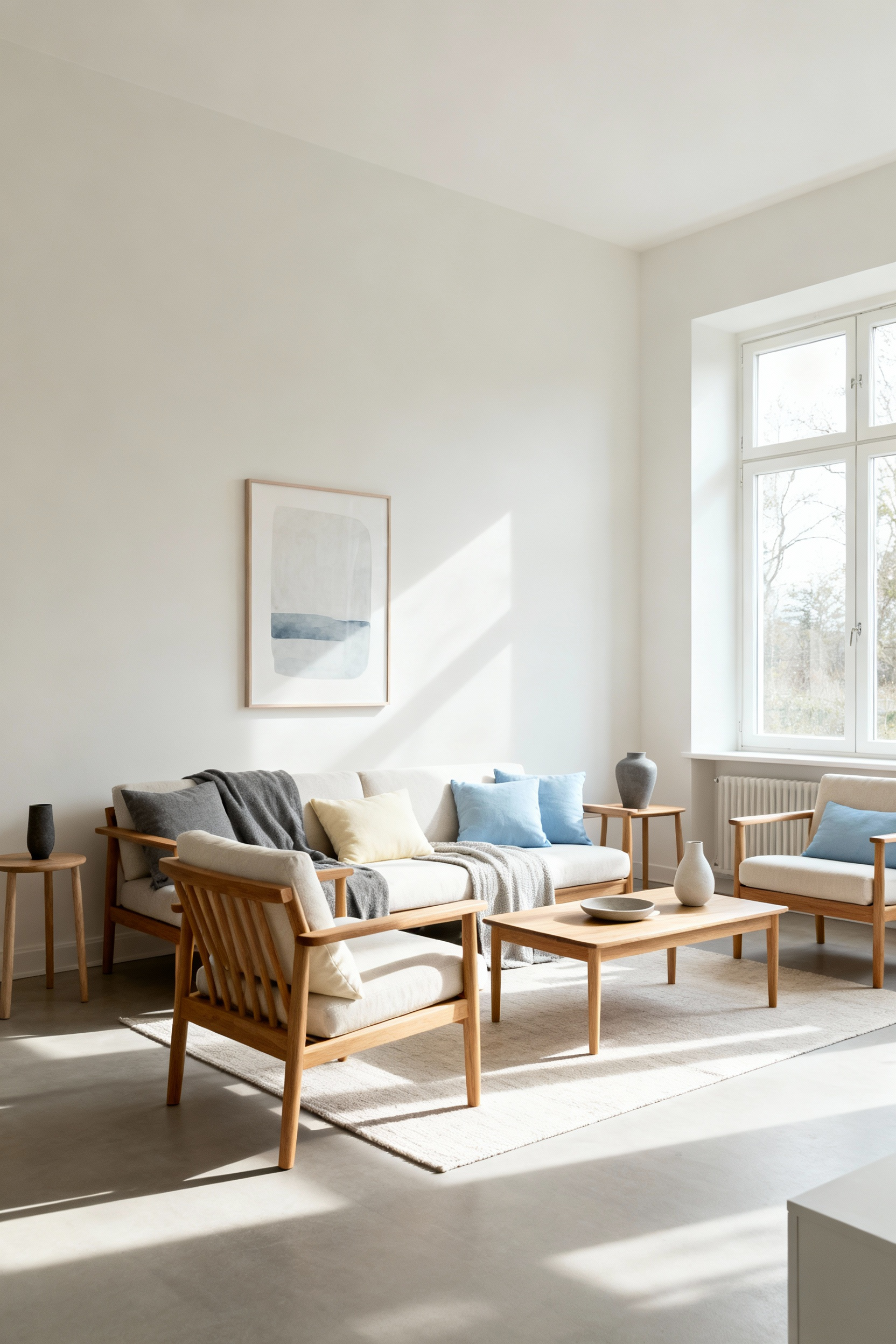
This means choosing furniture that fits the scale of your room—a sofa that seats comfortably without devouring the floor plan. It means balancing textures: a soft wool rug against the clean lines of a wooden coffee table. Visually, a substantial armchair might be balanced by a delicate floor lamp across the room. Negative space—the empty areas—is not a void to be filled but a tool to let the other elements shine. It gives your eyes, and your mind, a place to rest.
A core tenet of Nordic design is a deep respect for longevity. This isn’t just about being practical; it’s an ethical choice to value enduring quality over fleeting trends. We design for generations, not seasons. This means selecting furniture and materials that are not just beautiful today but will age with grace, acquiring a patina that tells a story of the life lived around them. It is the ultimate form of sustainability.

In practice, this translates to investing in pieces made from honest, robust materials like solid oak, ash, or walnut. You look for quality craftsmanship in the joinery and finishes. The forms are often timelessly simple, with clean lines that can adapt to changing styles around them. This creates a stable, versatile foundation for your living room that can be refreshed over the years with smaller elements like textiles or art, without needing a complete and wasteful overhaul.
While Charles and Ray Eames were American, their belief that beautiful form and practical function are inseparable speaks directly to the Scandinavian heart. This principle demands that every item in your living room must justify its existence on two fronts: it must work well, and it must be beautiful while doing so. One without the other is a compromise we choose not to make. The goal is a space that is profoundly livable and effortlessly efficient.
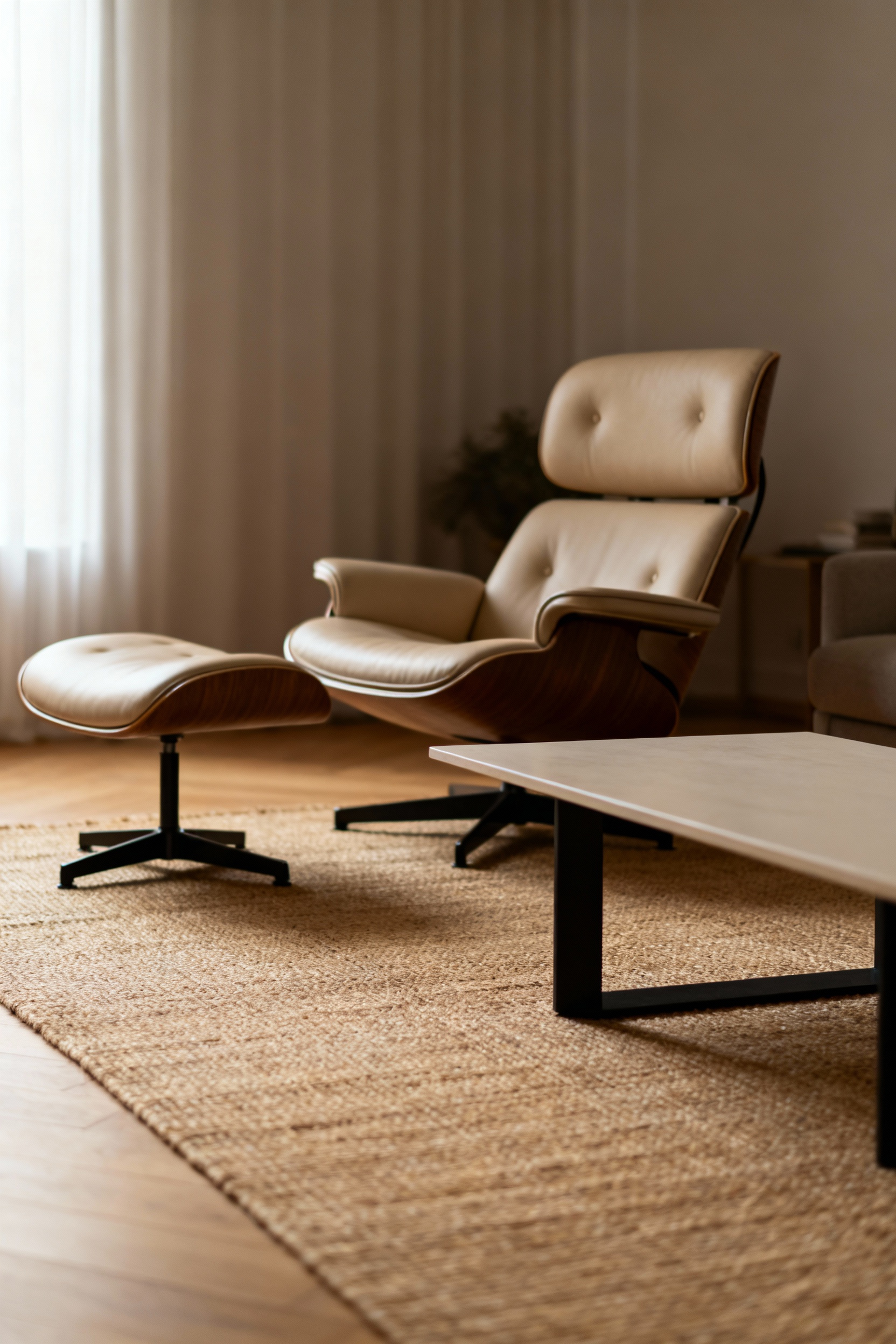
When you select furniture with this in mind, you ask different questions. Does this sofa’s elegant silhouette also offer deep, restorative comfort? Does this coffee table’s clean design cleverly conceal much-needed storage? You look for intelligence in the design—the graceful curve of an armchair that perfectly supports your back. A living room curated this way is a joy to live in because it works with you, creating a seamless experience where beauty is an inherent quality of useful, well-crafted things. In my experience with Scandinavian design principles, this synthesis is what truly separates good design from great design. It’s when you stop noticing the object because it performs its function so perfectly, yet its beauty continues to quietly enrich the space.
Building on those foundational ideas, we now look at how a simple element like color can profoundly shape the emotional landscape of your home. It’s about more than just paint; it’s about curating a visual environment that actively fosters a state of quietude and clarity.
Color in a Scandinavian home is a tool for psychological well-being. The goal isn’t to create drama but to reduce visual noise and cultivate tranquility. We turn to a palette drawn from the natural world—the muted greens of a forest floor, the dusty blues of a Nordic sky, the sandy tones of the coastline, and the soft whites of winter snow. These are not flat, sterile colors; they are nuanced, desaturated, and deeply calming.

To apply this, start with your walls. A soft, off-white or a muted sage creates a clean backdrop that beautifully reflects natural light. Anchor your room with larger furniture pieces, like a sofa, in natural linen or wool in shades of pale grey or warm sand. Then, you can layer in richer—but still muted—tones through textiles. Think of a rust-colored ceramic vase or the deep green leaves of a healthy plant. This approach ensures your room feels harmonious and grounded, a true sanctuary from the visual chaos of the outside world. I’ve noticed clients often fear that a neutral palette will be boring, but the reality is the opposite. When the background is calm, you start to appreciate the subtle textures and forms of everything in the room, from the grain of the wood to the weave of a blanket.
A true sanctuary appeals to more than just the eyes. It invites touch. This section is about the importance of honest materials and the rich textures they bring, creating a layered, sensory experience that connects us to the calm of the natural world.
Wood is the soul of a Scandinavian interior. It grounds us. But we prefer it in its most honest state. Rather than hiding it under thick lacquers, our philosophy is to celebrate the grain, the knots, and the subtle imperfections that tell the story of a tree’s life. This connection to a living material brings an unparalleled warmth and authenticity to a room.
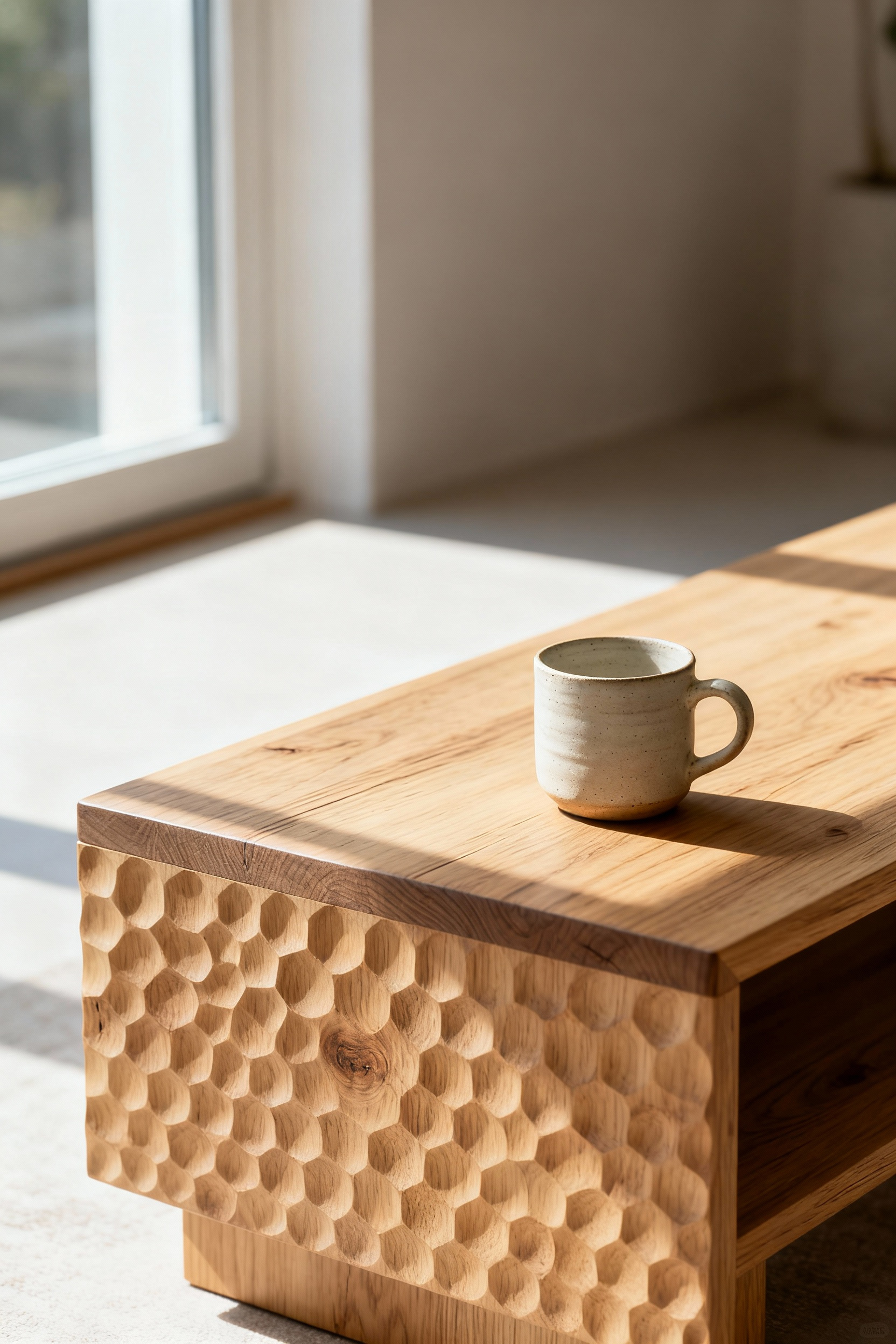
Look for pieces made from solid oak, ash, or birch with a simple oil or wax finish that lets you feel the texture of the grain. A solid wood coffee table can be the grounding centerpiece of your room. Open shelving in natural timber brings linear warmth. Even the wooden legs of a chair or sofa contribute to this tactile language. This approach ensures your home feels both contemporary and deeply rooted in a tradition of craftsmanship.
If wood is the structure, then textiles are the embrace. They are the essential counterpoint, adding softness, absorbing sound, and inviting us to slow down and get comfortable. A room without natural textiles can feel stark and cold; with them, it becomes a nurturing and inviting space. The focus is on the feel of the material against your skin.
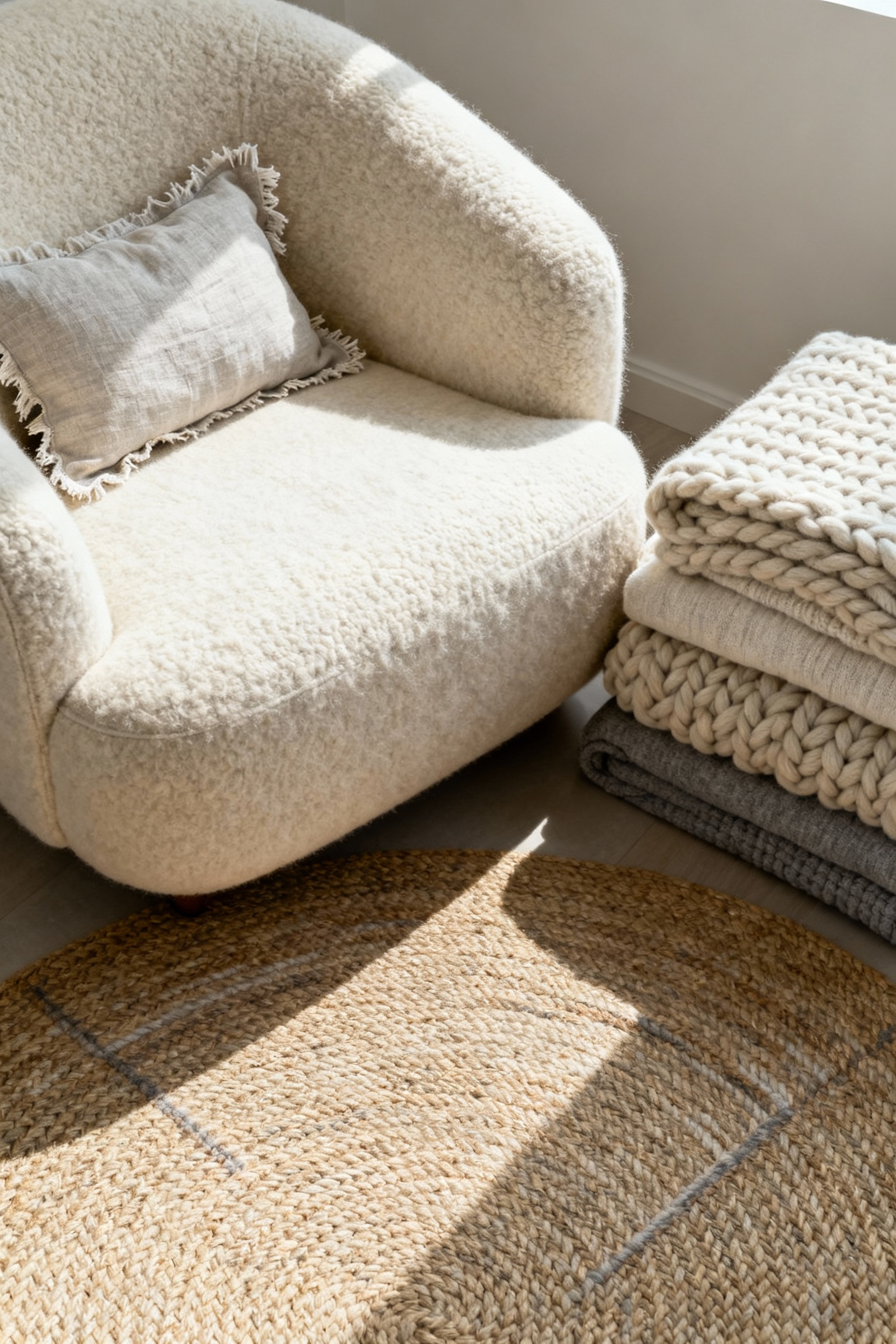
Drape a chunky wool throw over your sofa. Add cushions in nubby linen or soft, unbleached cotton. Anchor the space with a large area rug in woven jute or wool—it not only feels good underfoot but also helps create a quieter, calmer acoustic environment. These layers of natural fibers are the essence of hygge. They appeal directly to our fundamental human need for warmth, comfort, and security.
To balance the warmth of wood and the softness of textiles, we introduce the cool, solid presence of geological elements. Natural stone and handcrafted ceramics bring a sense of permanence and an ancient, quiet strength to a space. They provide a grounding force that is both sophisticated and deeply connected to the earth.

This could be a low coffee table with a honed travertine top or a side table with a simple ceramic base. A fireplace hearth made from slate becomes a powerful focal point. Even small touches matter: a hand-thrown stoneware vase holding a single branch, a heavy marble bowl on a shelf, or a lamp with a terracotta base. The interplay between these cool, hard surfaces and the warmer elements creates a beautifully balanced and dynamic environment.
Going beyond simply using natural materials, we can draw inspiration from nature’s forms. Biomimicry is the art of looking to the organic silhouettes of the natural world—the gentle curve of a river stone, the imperfect shape of a leaf—and reflecting them in our furniture and decor. These flowing lines inherently reduce visual tension and foster a sense of effortless grace. What I tell my clients is that right angles don’t often appear in nature, so by softening the edges in our homes, we create a space that feels more intuitive and less rigid.
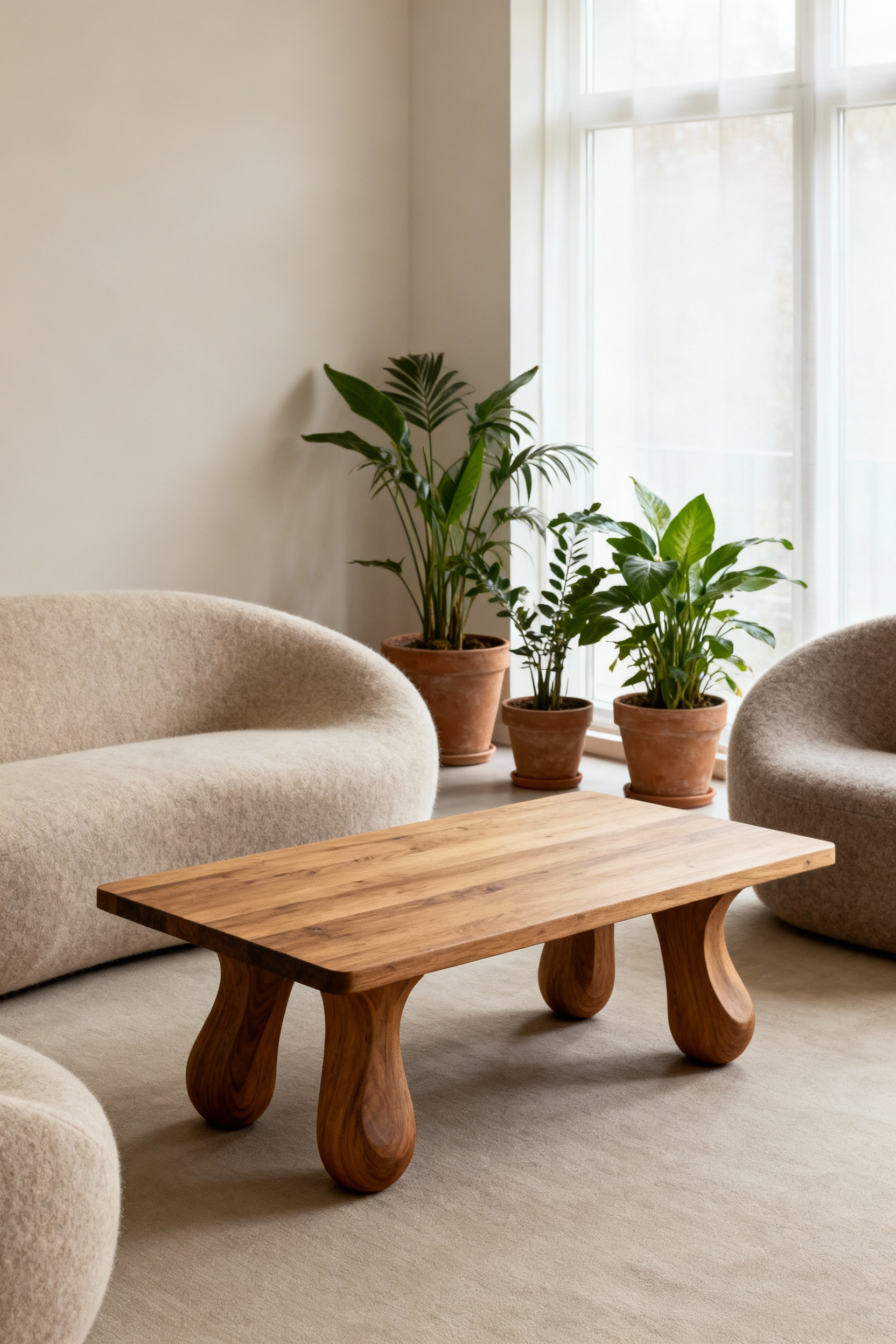
Look for a sofa with gently rounded corners, or an armchair that feels like an embrace. Choose a coffee table with a soft, kidney-bean shape instead of a hard rectangle. A pendant light might be inspired by the form of a water droplet. These subtle choices have a powerful effect, creating a living room that feels fluid, harmonious, and deeply calming. It’s a way of letting the perfect artistry of the natural world into your home.
Here, we continue our exploration of the tangible, focusing on how living elements can become integral parts of our design. Biophilic design is more than just having plants; it’s about creating a conscious, breathing connection between our indoor sanctuary and the natural world outside.
Our innate connection to nature, known as biophilia, is a powerful tool for well-being. Plants are not afterthoughts or simple decoration; they are living, breathing members of the household that actively improve our environment. They purify the air, reduce stress, and introduce a dynamic, organic beauty that no inanimate object can replicate. In a Scandinavian home, this integration is essential for creating a space that truly feels alive.
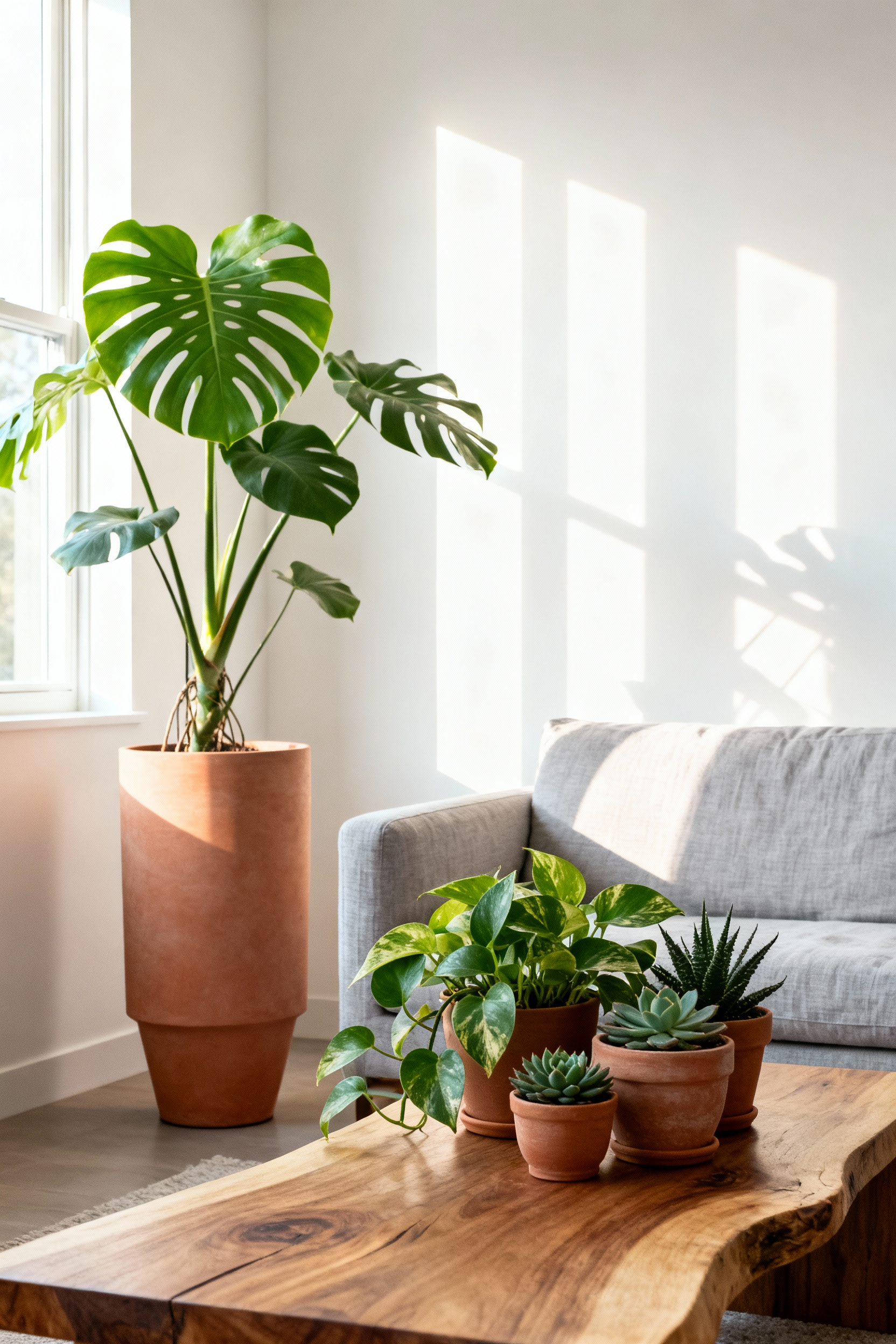
Think of plants as living sculptures. A tall Fiddle Leaf Fig can anchor a corner and draw the eye upward, adding height and drama. A collection of smaller succulents on a windowsill creates an intimate, detailed vignette. Place them where they will thrive, but also consider the beautiful shadows they cast as the sun moves across the room. Choose planters made from natural materials like terracotta, ceramic, or woven baskets to maintain the organic connection from leaf to pot. I’ve learned from years of Nordic interior design that the simple act of caring for plants—watering, pruning—becomes a quiet, grounding ritual that connects us to the slow, steady rhythms of nature.
How we move through a space profoundly affects how we feel in it. This section focuses on the intelligent arrangement of your living room, ensuring it not only looks beautiful but also flows with an effortless, intuitive grace. It’s about creating a blueprint for calm and purposeful living.
In the Nordics, where daylight can be a precious commodity, we treat it with reverence. Natural light is a vital nutrient for our well-being, and our primary goal is to invite as much of it as possible into our homes. Our design philosophy doesn’t block light; it diffuses and celebrates it. The way a room is lit by the sun directly influences its energy and perceived size.
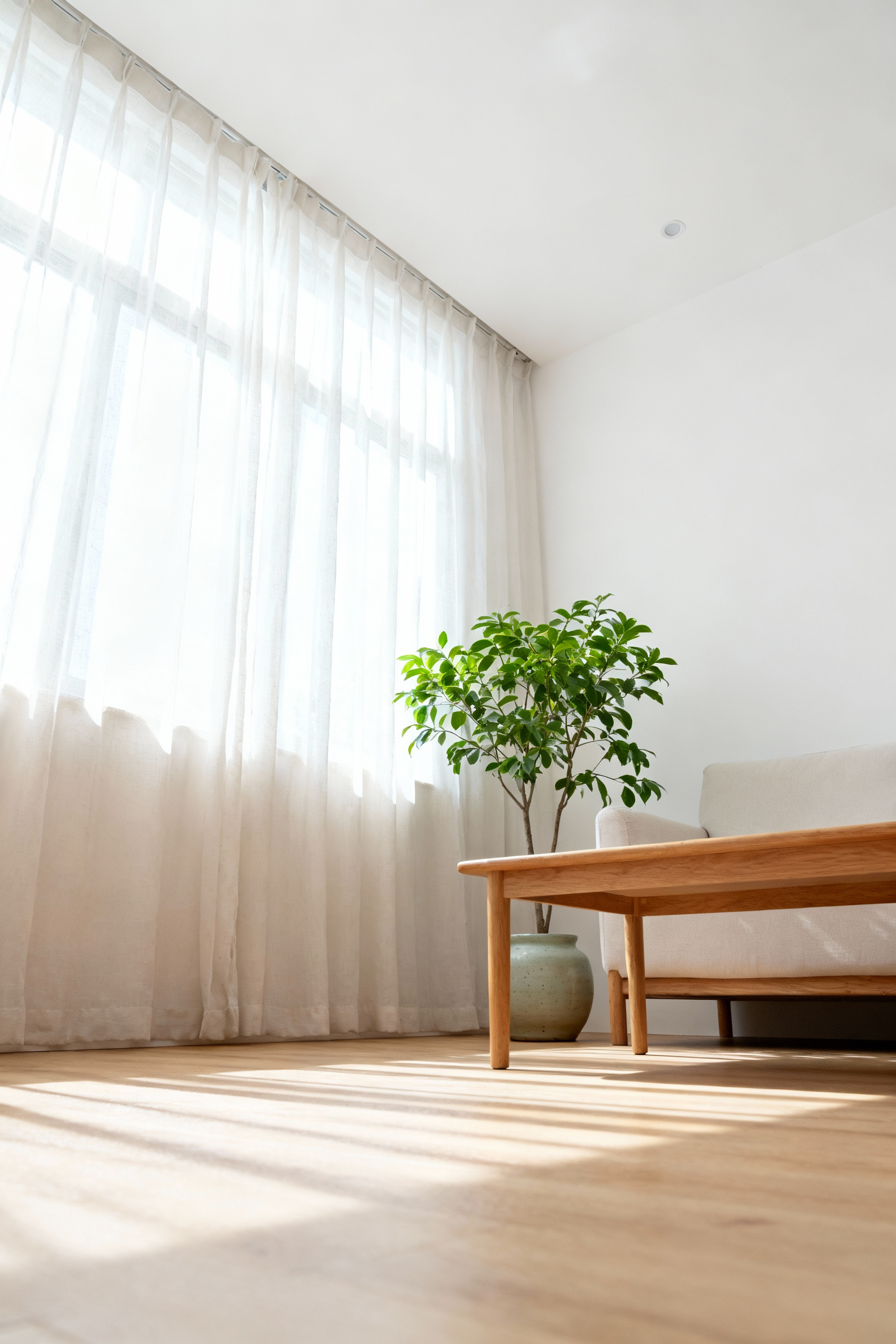
This means forgoing heavy, light-obstructing curtains. Instead, opt for sheer linen panels that soften sunlight into an ethereal glow without blocking it. Simple wooden blinds allow you to control for privacy while still letting slivers of light through. Keep window sills uncluttered. You can also strategically place a mirror on a wall opposite a window to amplify the light and bounce it deeper into the room, creating an effect that is both practical and beautiful.
Open-plan living is wonderful for connection, but it can feel chaotic without a sense of order. We need to create “rooms within a room” to guide activity without putting up walls. The goal is to define zones of purpose—a space for conversation, a corner for reading—using subtle visual cues that create functional fluidity.

An area rug is the simplest and most effective way to do this. It can anchor your main seating arrangement, creating a clear conversational island. A low, open-backed bookshelf can suggest a boundary between the living area and a small workspace, defining the two without blocking light or sightlines. Even a large, well-placed plant can act as a natural and beautiful room divider. These subtle delimiters bring a calming sense of order to an open space.
Our lives are not static, and our homes shouldn’t be either. A truly intelligent living space is one that can adapt to our changing needs. This philosophy embraces flexibility, allowing our homes to evolve with us, whether that means making room for a growing family, a new hobby, or simply the desire for a fresh perspective. Modular furniture is a key tool for achieving this kind of adaptive versatility.

Think of a sectional sofa that can be reconfigured from an L-shape for family movie nights into two separate couches for hosting a party. Nesting coffee tables can be separated for guests or clustered together. This approach is inherently sustainable, as it allows you to reinvent your space without buying all new furniture. It puts you in control, ensuring your living room serves the life you are living now.
This might be the most important—and most misunderstood—principle in minimalist design. Negative space is not just “empty” space; it is an active and essential element. The uncluttered areas of a room—the quiet stretch of a wall, the open floor—are what give the objects that are there their power and beauty. It’s the visual equivalent of a pause in a piece of music. What really gets me is when I see a space where every surface is covered. The eye has nowhere to rest, and the mind feels just as cluttered. True serenity comes from giving your belongings—and yourself—room to breathe.

Practicing this is an exercise in restraint. Resist the urge to fill every corner. Let a beautiful armchair stand on its own without a side table cluttered next to it. Hang a single, meaningful piece of art on a wall and leave the rest bare. This thoughtful curation elevates every item, turning your living room into a calm, gallery-like space where the focus is on quality, form, and light. It’s a powerful way to bring a sense of profound peace into your home.
Building on these principles, we now consider the invisible currents that shape our experience of a room. How we navigate a space is not incidental; it’s a fundamental part of its design. Orchestrating an intuitive flow transforms a layout from a static plan into a living, breathing environment.
Flow is the feeling of moving through a room effortlessly, without obstacles or awkward turns. It’s an invisible architecture that guides you. When circulation paths are clear and intuitive, it reduces subconscious friction and creates a tangible sense of ease. The goal is to design a space where every journey, from the doorway to the sofa, feels completely natural.
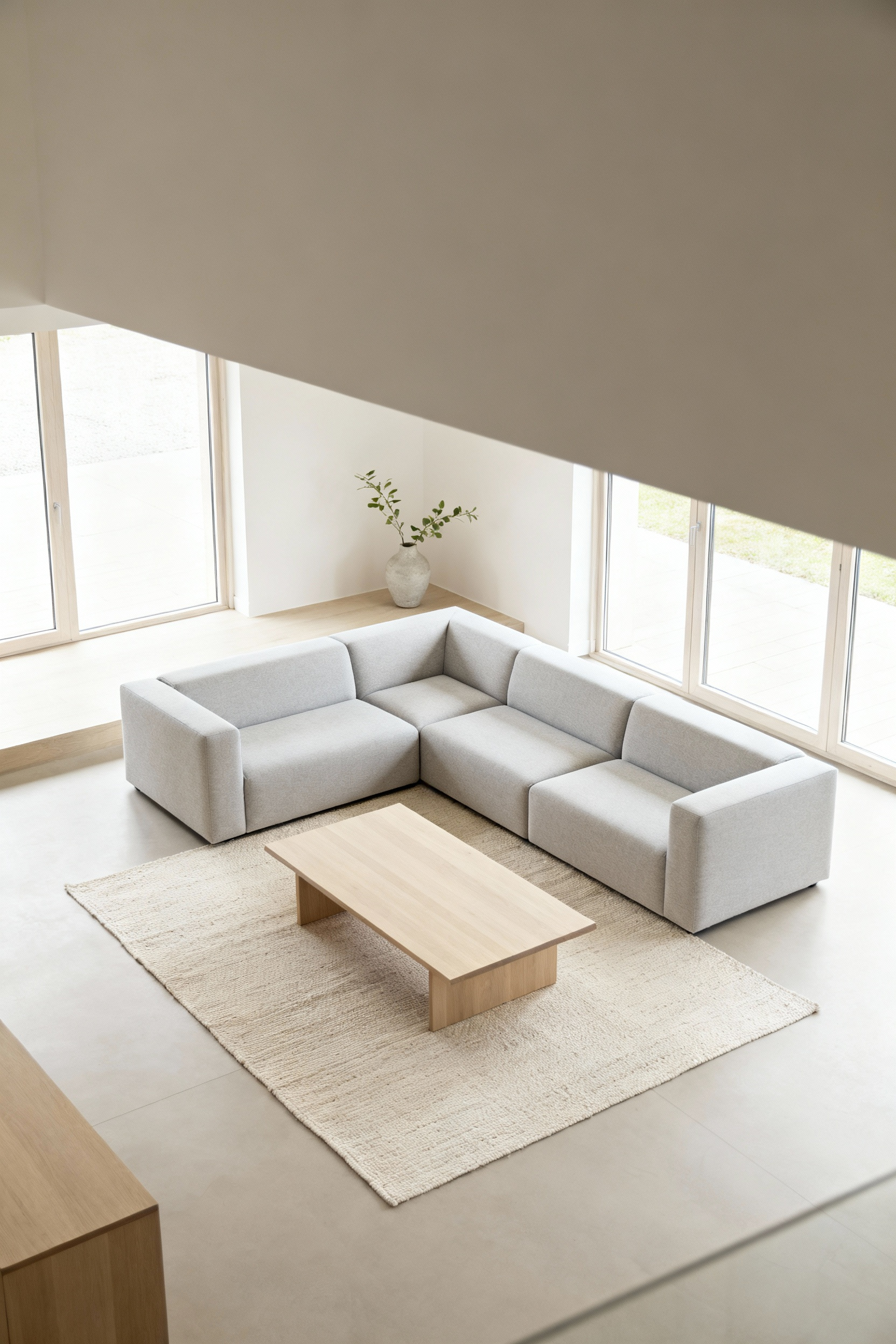
To achieve this, ensure your main pathways are at least three feet wide. Arrange your furniture to define destinations—like a cozy seating area—without blocking the routes to get there. It’s often better to pull furniture away from the walls to create walkways behind it. Choosing pieces with legs that lift them off the floor also helps, as it allows light and air to pass underneath, creating a lighter, more open feeling and preventing a layout from feeling heavy or blocked. Years of working with hygge principles and natural materials taught me that a feeling of ease is paramount; a cluttered path is a cluttered mind.
A house becomes a home when it tells your story. Our living spaces should be dynamic canvases that reflect who we are and what we cherish. This section is about weaving your personal narrative into your design, creating a sanctuary that is uniquely and beautifully your own.
The most beautiful objects in your home are the ones with stories. A home should be a repository of your life’s journey, not a sterile showroom. Curating your personal artifacts—mementos from travels, inherited heirlooms, handmade gifts from friends—is what gives a space its soul. These items are the tangible anchors of memory, each one holding a piece of your biography.

The key is to display them with intention. Don’t clutter every surface. Instead, create small, thoughtful vignettes on a bookshelf or a console table. Let a single, beautiful object have its own space to be appreciated. The principle of negative space is your friend here; it gives these meaningful items the prominence they deserve. By surrounding yourself with pieces that resonate deeply, you create a living room that offers constant comfort and inspiration.
Our living rooms are often the hardest-working rooms in the house, serving as a place to relax, work, entertain, and play. A serene design must anticipate these dynamic daily rhythms. This philosophy moves beyond single-purpose furniture to embrace clever, multifunctional pieces that allow the space to adapt seamlessly from one activity to the next.

A beautiful coffee table might have a hidden lift-top to become a comfortable desk for remote work. An elegant ottoman can provide extra seating for guests and contain hidden storage for blankets or toys. A deep window sill could be designed as a cozy reading nook. By planning for multifunctionality, you create a space that feels uncluttered and efficient, gracefully accommodating all the facets of modern life.
We’ve already discussed the importance of layering light for hygge, but we can take it a step further. An advanced lighting plan allows you to actively modulate the ambiance of a room to support your well-being. This is about understanding that light isn’t just on or off; it has color temperature and intensity, and controlling these variables allows you to sculpt the mood of your space.
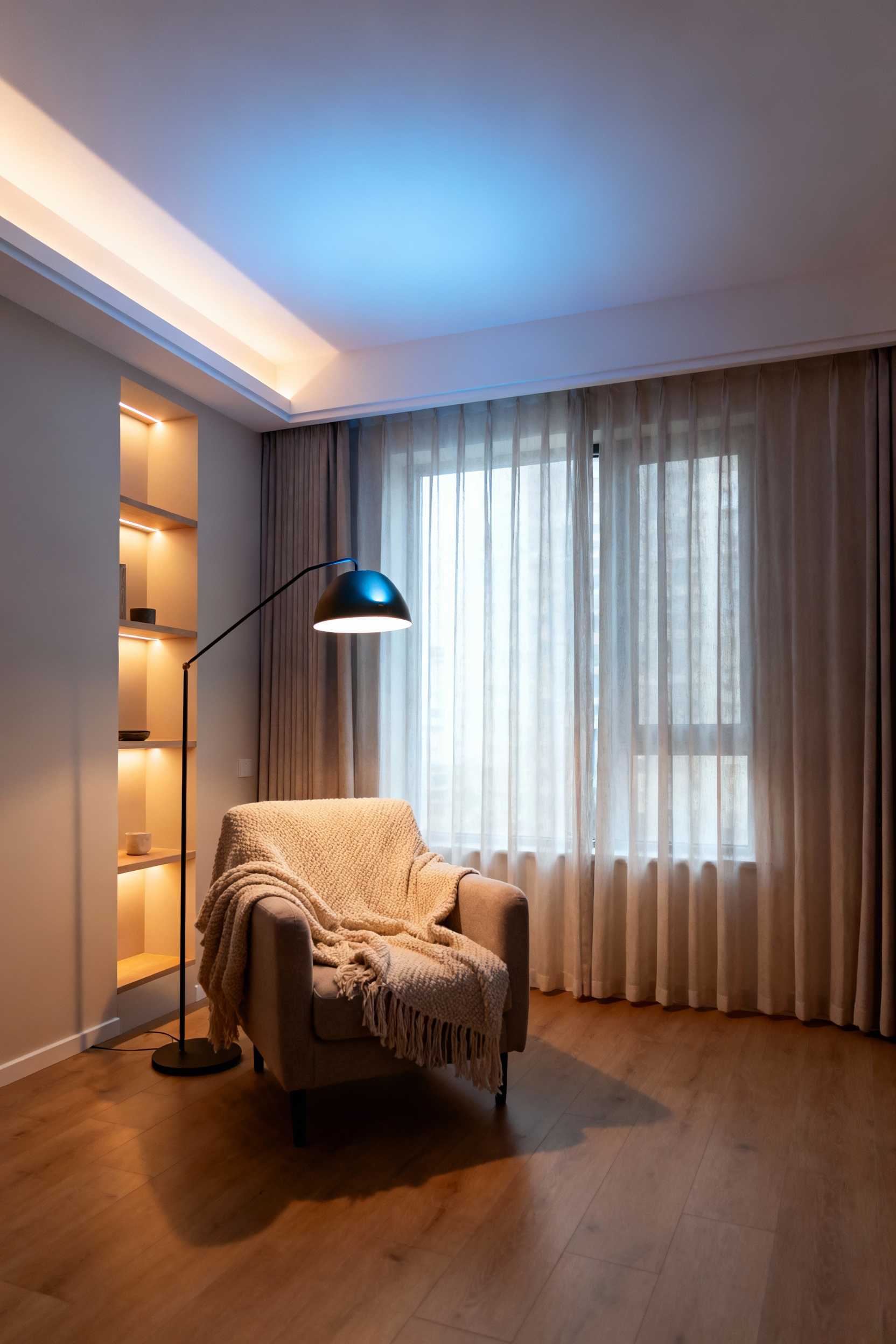
All of your key light sources—ambient, task, and accent—should be on dimmers. This gives you complete control. You can have bright, cool-toned light during the day for focus and energy, and transition to a warm, low-level glow in the evening to signal to your body that it’s time to unwind. This is a subtle but incredibly powerful way to align your home environment with your natural circadian rhythms, enhancing your overall sense of well-being.
A truly serene space is maintained through the practice of mindful stewardship. This means embracing the “deliberate edit”—a commitment to consciously curating your environment and resisting the pull of mindless consumption. Minimalism isn’t about deprivation; it’s about discerning selection. It is the clarity that comes from being surrounded only by things that are useful, beautiful, or deeply loved. What I often see is that this discipline of editing a physical space has a powerful knock-on effect, helping to bring a similar sense of clarity and focus to other areas of one’s life.
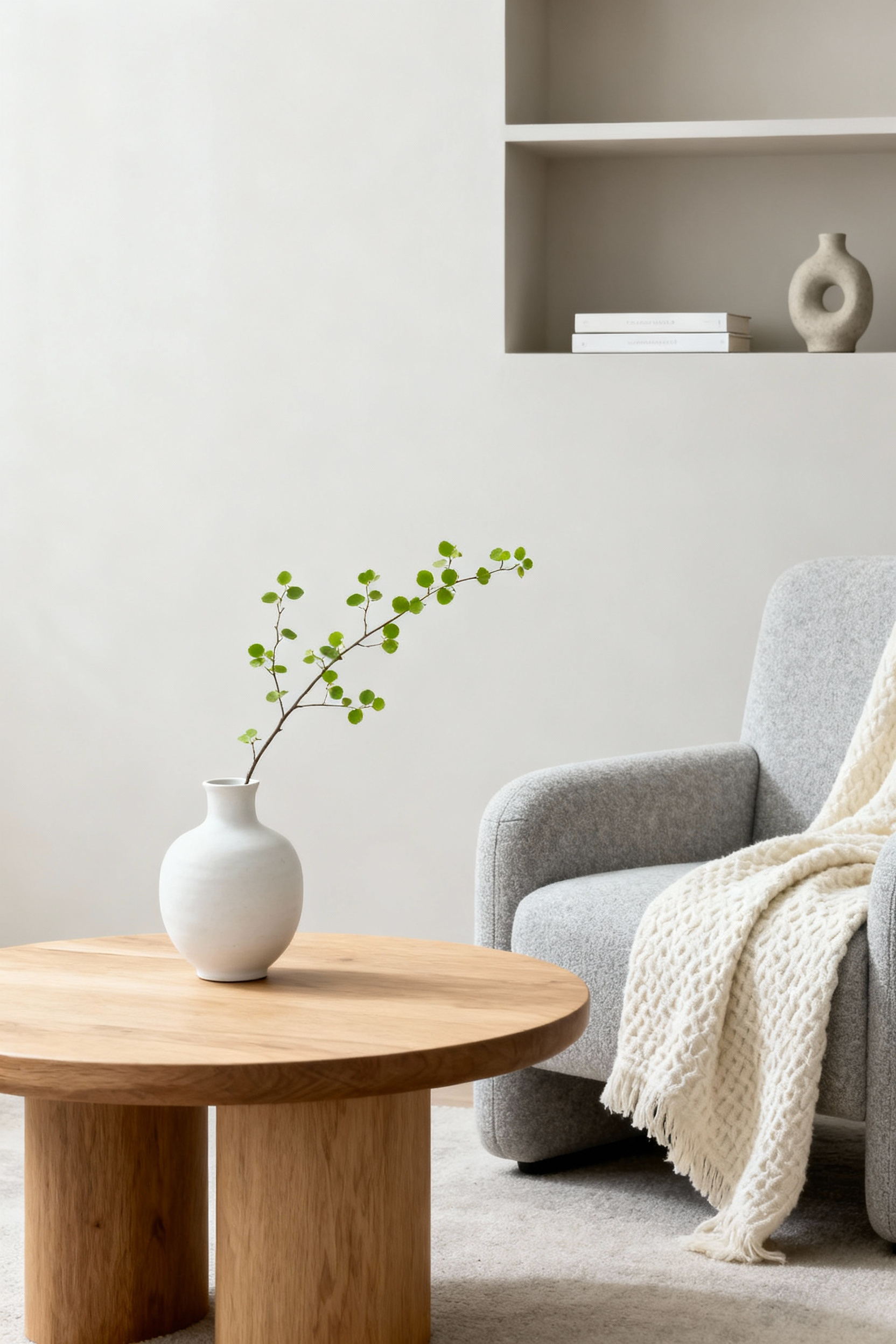
This is an ongoing process. Regularly assess what’s in your room. Do you still love it? Does it still serve a purpose? It’s okay to let things go. A seasonal refresh is a wonderful opportunity to do this—not to buy new things, but to declutter, rearrange, and see your space with fresh eyes. This practice ensures your home remains a vibrant and calming reflection of who you are today, not who you were years ago.
Finally, we engage a sense that is often overlooked in design but is incredibly powerful in shaping our experience of a space. Olfactory ambiance—the scent of a room—is the invisible layer of design that can evoke memory and create a deep, lasting sense of comfort.
Scent has a direct line to our emotions and memories. Cultivating an olfactory ambiance is the final, invisible layer of creating a sanctuary. It’s about choosing a signature scent for your home that promotes calm and well-being. A home that smells good instantly feels more welcoming and serene. The key, as always, is naturalness.
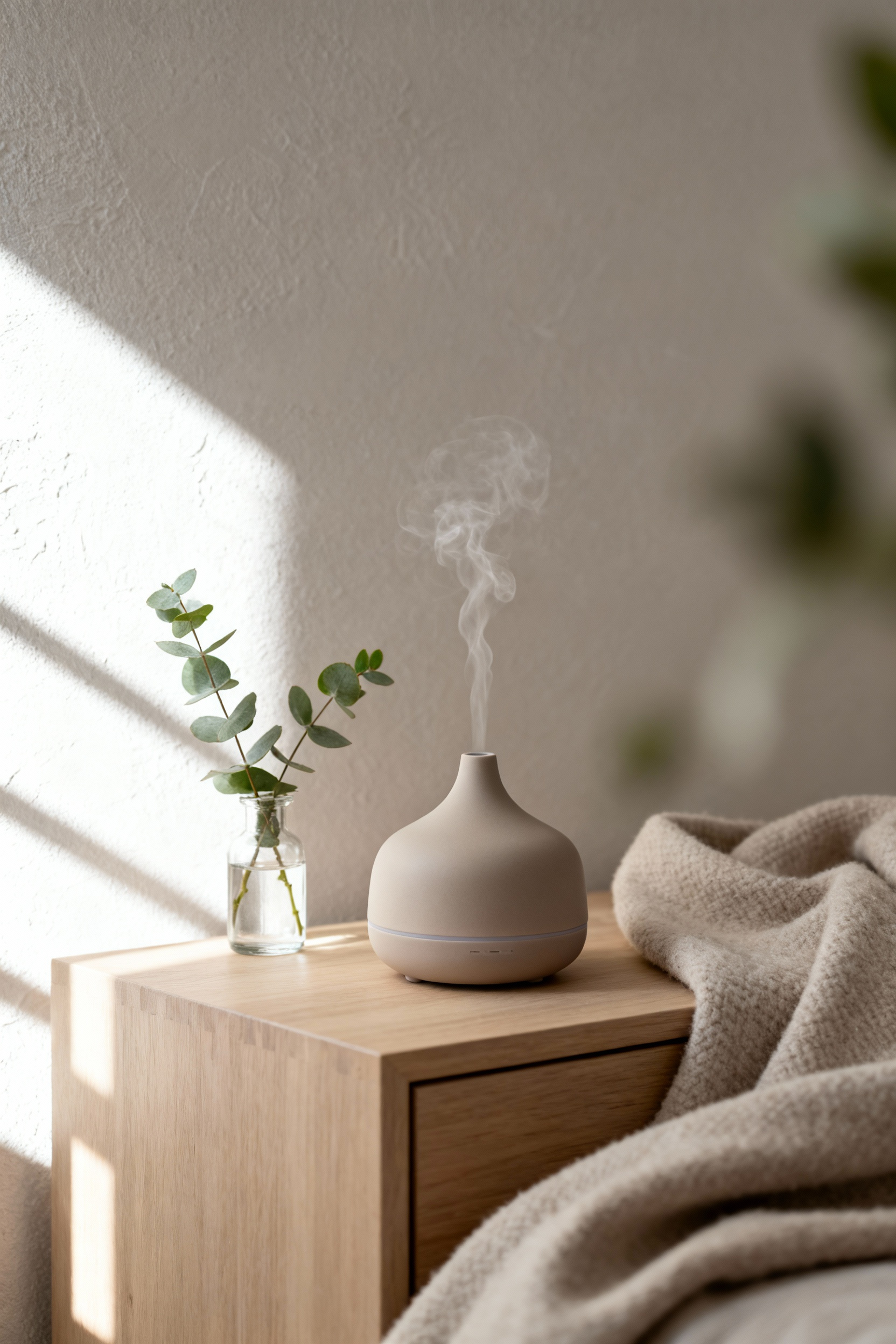
Avoid artificial air fresheners with their harsh, chemical notes. Instead, turn to pure, botanical sources. Diffuse high-quality essential oils like grounding cedarwood, calming lavender, or clarifying eucalyptus. Light candles made from natural soy or beeswax with subtle, clean scents. Even a simple pot of simmering water with cinnamon sticks and citrus peels on the stove can fill your home with a comforting aroma. The goal is a gentle, background fragrance that you almost don’t notice, but that contributes profoundly to the overall feeling of peace and presence. This completes the sensory picture of your living room sanctuary.
Across these twenty insights, a clear picture emerges: creating a serene living room sanctuary is not about following a set of rules. It is a mindful practice of crafting a holistic environment. By weaving together the foundational principles of intention with the tactile beauty of honest materials and the intelligent harmony of a well-planned layout, you transform a room from a simple collection of things into a space that truly nurtures and restores you. This is the enduring power of the Scandinavian design philosophy.
These ideas are not meant to be a rigid prescription, but rather a guide to help you find your own expression of calm. Use this living room inspo as a starting point. Experiment, listen to your intuition, and be patient. The most beautiful spaces are those that evolve over time, gathering layers of personal meaning and history. Your home should be the truest reflection of your own pursuit of a quiet, contented, and beautiful life. May it be a perennial source of comfort, inspiration, and profound peace.